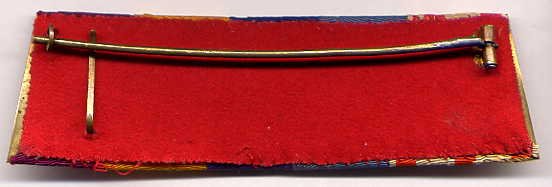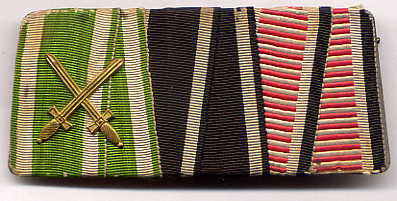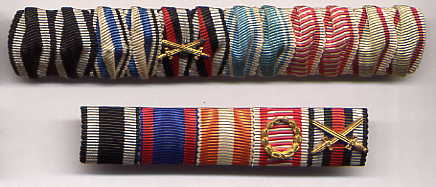
Content - Richard Lundström
Layout - Sebastian Bianchi
Before The World Wars
With the changes in uniforms brought about by the wars of the 1860s and the Franco-Prussia War of 1870-1871, non-parade dress ribbon bars for officers began appearing in the 1870s. During the long post-Napoleonic peace, there had been little opportunity for most German regimental officers to have ever acquired more than a long service award and the basic Captain's or Major's level home state Order for a lifetime of duty. The proliferation of campaign medals and crosses, with the accompanying variety of bravery decorations in the 1860s and early 1870s for the first time meant that even fairly junior peacetime (again) officers might actually be entitled to wear an impressive array of awards. It was at this time that national style differences in the various semi-independent states of the new federal German Empire altered the fairly sloppy unsupported drapes and austere trapezoid parade medal mountings of the pre-1870 period.
Prussia and the states most closely in Prussia's orbit adopted an "undress" version of ribbons-only bar identical to the old style full dress: a truncated pyramid, trapezoid form, 40 mm high, with two sections of full width ribbon crisscrossed and overlapping on multiple ribboned bars.
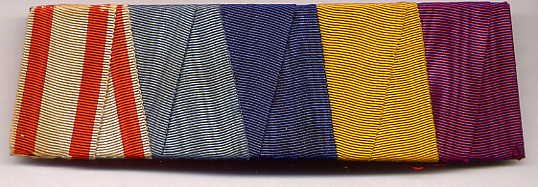
"TP"
Bavaria adopted a "fatter" style bar, usually with padding under the ribbon, and the two sections of ribbon more or less side by side rather than in inverted V shape. While the Prussian style ribbon bar had no hooks on back to wear full medals - thus distinguishing an officer's ribbon bar from an enlisted man's parade dress mounting - the Bavarian all ranks style almost always had either hooks on back or spring clips in front to convert a ribbon bar to a parade medal bar at a moment's notice. This thrifty south German style remained popular into the early days of WW2, and will be seen illustrated in the World War One section of the article and later.
|
|
| The hook behind the last ribbon is either to speedily mount only this award on a visit from the presenting ruler, or had something to do with uniform fastenings. TP |
By the turn of the 20th century, most of these old Wilhelmine warriors were retiring. Imperial Germany's new involvement in colonial campaigns gave a new generation of officers a reason to wear service dress ribbons again.
|
|
| A Herero-Hottentot War of 1904-06 ex-Schutztruppen officer's bar for a Saxon. RV |
The Imperial German navy, Kaiser Wilhelm II's favorite service, had much less of a tradition of undress award wear. Shipboard duties did not normally require any such display, in the corrosive effects of salt water. The only evidence I can find of ribbon bar wear in the navy before 1914 is of small trapezoid 15 mm width sewn on ribbons worn on the waist length mess dress "monkey" jacket.
|
|
| This unique bar dates from May 1914 and belonged to the later Generaladmiral zS Conrad Albrecht (1880-1969). Rank Lists and other reference sources can sometimes identify a literally unique group like this. Note that swords on the Greek Redeemer Order are incorrect, while swords on the Norwegian St. Olaf Order merely indicate bestowal on any military recipient and not wartime action. |
This style would remain a favorite and characteristic of the German navy until the outbreak of World War Two. It utilized the existing ribbon width used on civilian lapel bows - the most common form of award wear outside the military. [illustration 5-caption "This circa 1897 lapel bow was worn by a former career Prussian NCO/Naval PO 1870/71 veteran who then went into the civil service. TP"] In some ways, then, the Imperial navy's ribbon bars may be taken as the direct forerunners of the style adopted from 1915.
World War One
As summer turned to autumn 1914 and casualties among the German officer corps reached 25%, one of the obvious lessons learned was that the huge, vividly colored ribbon bars worn on garrison duty for the last 40 years were NOT practical in the field, where they helped enemy marksmen distinguish officers as targets.
|
|
| This bar, also a unique combination which made tracing its "anonymous" original owner possible, belonged to Hauptmann Friedrich von Brömbsien (b. 1877), killed in action at Fort Brimont 16 September 1914 as Adjutant of the 25th Infantry Brigade. TP |
Though this style remained popular for behind the lines semi-dress, it was clearly no longer practical at the front. As the war entered its second year in the late summer of 1915, period photographs reveal officers at the Captain and Major level sprouting three or even four war award ribbons out of their tunics' second buttonhole - the traditional place for wearing the Iron Cross 2nd Class since 1813. Some officers even wore multiple ribbons out of more than one buttonhole. As a temporary expedient, this was little better than the larger ribbon bars, still offering enemy sniper's a splendid target area, as well as looking messy. With more than two dozen states bestowing war decorations, this situation was getting out of control.
The solution was the A.K.O. of 21 September 1915 #735, which prescribed for Prussian and Imperial forces a smaller ribbon bar, only 17 mm in height. Though unspecified in the text, this small "Feldspange" as it became known would most normally employ the old pre-existing lapel bow 15 mm width ribbons. Württemberg issued its own regulations in line with Prussia's by A.K.O. of 10 October 1915 # 761, followed by Saxon A.K.O. 9 November 1915 #265 and trailed by Bavarian A.K.O. 1 April 1916 #33730. The Prussian War Ministry noticed enlisted men had been overlooked, and by Order KrM # 374 of 29 August 1916 officially laid down that the ribbon bars for enlisted men would match the "New Style" officers' ribbon bars, while enlisted full dress would remain the "Old Style" trapezoid form. The basic shape of German ribbon bars had been established for the next 30 years.
These earliest German ribbon bars remained rather awkward and easily damaged things. Like the large Old Style officers' ribbon bars, they were cut out of thin sheets of steel which had been tinned to retard rusting - little different than the lid of a tuna fish can. The edges were sharp, fraying ribbons stretched over the back and sewn down. Hooks and hinges were stamped out of the same metal and soldered in place (see the section on bars' hardware), and almost never had any holes for the myriad tiny devices (see the section on devices shown at x500% size) that became required to differentiate different classes of awards as the war continued. This mean that the prongs on the backs of WWI era devices were simply bent against the reverse of the ribbon before it was sewn down, on top of the metal backing plate - easily causing snagging and breakage.
|
|
| The green enameled round wreath device on the second ribbon for Baden's Military-Karl-Friedrich-Merit-Order has fallen off, leaving the attachment prongs behind like splinters between the ribbon and tinned steel backing. |
At some point during the war, as now millions of men began receiving multiple awards, someone had a better idea. Ribbon bars with flat metallic backings, holed to allow individual ribbons on a metal tab backing to be custom affixed with less need for time consuming hand stitching, began appearing. The earliest versions are invariably entirely painted in Feldgrau paint on all the metal hardware, stamped first "D.R.G.M." for "Patent Pending" and then "D.R.P." for "Patented in the German Reich." Each individual tab backed ribbon mount was punched with a hole to allow device prongs to be bent through, helping fasten the ends of the ribbon and then all was sandwiched against the flat backing plate.
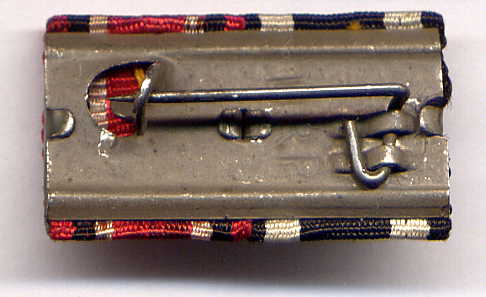
TP
This efficient and logical style of mounting continues in German use today, although sizes have changed. Old Feldgrau painted stock may occasionally be found being used on bars made into the mid 1930s, but from the 1920s, normally the metal was cheaply flashed with tin or nickel that easily rusts through , or the tab back mounts were was made out of aluminum on a bright flashed steel backing plate - see the post WWI sections.
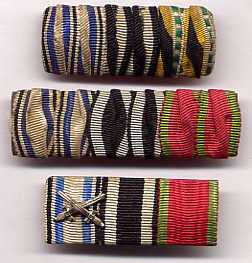
In Bavaria and the south German states, the double draped style was preferred, even on the small M1916 Feldspangen , though the Prussian M1915 style was also worn. Naval officers wore either the Prussian type, or an updated version of the earlier trapezoid mess dress, either still sewn on or pinback.
|
|
| Although a "German awards only" wartime bar, this combination was unique in the Imperial Navy to later Konteradmiral zS Heinrich Kehrhahn (1881-1962), and would have been traceable to him even had it not in this case come along with a matching bar with his full awards. The importance of reference materials cannot be overemphasized. |
Many more of each type will be shown following the brief historical overview section. Indeed, the semi-independent kingdoms of Bavaria, Saxony, and Württemberg were legally entitled to wear their own wartime awards before the Prussian Iron Cross, which - although in reality a "Reichs" Imperial distinction - retained its status as a mere Prussian state award until 1935.
The Weimar Republic
With the collapse of the German Empire, all regulations concerning awards were abandoned. The new Republic was officially hostile to all awards, and it would be years before even such worthy civic distinctions as state life saving medals were re-established. The tiny Reichswehr: Reichsheer and Reichsmarine, preserved some semblance of the old orderliness, but even there, chaos lurked. The army seems to have held the plethora of unofficial and vanity self-purchase veterans' awards at bay. The navy certainly did not, and period photos reveal all sorts of private awards being worn with state sanctioned ones. Peacetime Orders, long service awards, and campaign medals from colonial wars went wherever their wearer wished, or the mounter happened to put them.
|
|
| Kehrhahn's 1920s bar, mentioned above. For no reason at all, his Oldenburg Friedrich August Cross follows his XXV Years Service Cross as if it were a foreign award like his pre-war Swedish Sword and Turkish Osmanie Orders! |
Civilians simply wore awards any way they wished. Hohenzollern House Order with Swords recipients advanced their enameled decorations before their Iron Crosses. Awards which could not - or should not - have been worn together WERE worn, any which way.
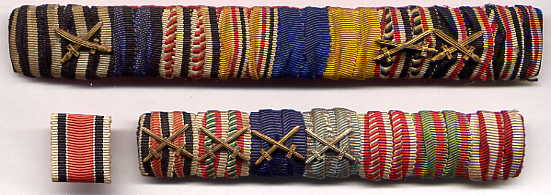 |
| Here we have a typical jumble of superceded awards still being worn, improperly, together-such as the old M1825 IX years Service Bar ribbon on the top bar, with its out of order XXV Years Service Cross, as well as some of the myriad of unofficial veterans awards which mushroomed in the 1920s and early 1930s. |
Men who had actually never seen ANY action could - and did - strut about with gaudy vanity/veteran bars whose spread was limited solely by their budget, and not by taste or discretion.
|
|
| The owner of this attractive bar would have had nothing to wear in 1935 but a lone Hindenburg Cross with Swords, replacing his 1920s vanity/veterans' awards here: "Germany's Honor in the East" Cross, Somme Campaign Cross, Champagne Campaign Cross, Verdun Campaign Cross. TP |
The lingering effects of this "open season" on award wear would be felt well into the regimented Third Reich.
Third Reich
When Adolf Hitler swept into power in 1933, the Weimar Republic was, like the old federal Empire, a patchwork of semi-independent states. Local awards for lifesaving and bravery or long service in firefighting had crept back in. A degree of order was reintroduced when the so-called "Hindenburg Crosses," intended for award as "Honor Crosses of the World War" by the doddering ex-General Field Marshal and figurehead President of the German Republic, was bestowed by Reichs Chancellor Hitler, sweeping away the hundreds of unofficial WWI veterans' group and mere vanity awards, beginning in the fall of 1934. It is still possible to find medal and ribbon bar groups from this late 1934-early 1935 period which retain the old "kingdom-before-Prussia" precedence of awards, but in early 1935 Hitler decreed that the universal Iron Cross of the world war would henceforth have pride of place throughout Germany. It was the first of many sweeping changes the award conscious Nazi leadership would make.
|
|
| This bar, belonging to a former Saxon Army NCO, still has that Kingdom's awards before the Iron Cross. The superfluous EK2 miniature device first appeared in 1919 and seems to have held on into the 1930s mainly in Saxony. It does NOT indicate possession of an EK1, as period photos clearly show, but was merely a pointless fashion affectation. RV |
From 1936 to the outbreak of World War Two, Nazi Germany would institute dozens of ribboned awards and make sweeping alterations in long established precedence regulations. Lifesaving medals would be swept from their deserved place and long service awards would drop behind war campaign awards. A new range of long service awards for political and paramilitary organizations, "flower campaign" medals, and Olympics decorations had to be fitted into revised precedence with existing awards. Absorption of Austria, the Sudetenland, and Bohemia in 1938-1939 meant amalgamation of Austro-Hungarian and some Austrian Republic awards among those of the "other" former Imperial German states.
|
|
| Here are two ribbon bars, before and after the Anschluss, showing first Austro-Hungarian awards at the end as foreign, and then intermingled with other "German" state awards for WWI. Wearers of older bars often continued wearing them unchanged, but anyone obtaining a newly made bar naturally followed the correct current regulations-see the Precedence Regulations Section of this article after all the illustrated material. TP |
With new awards in as much flux as the population of the ever-expanding "Thousand Year Reich," rules and regulations were often misinterpreted or ignored.
World War Two
In contrast to the flood of more than 50 different ribboned awards from the late 1930s, wartime Germany only created eleven new ribboned decorations for the new world war -- and the absolute maximum that any German might theoretically wear of all these was six. Devices were added to three more awards - the 2nd award bar to the 1914 Iron Cross 2nd Classes, and swords for frontline awards of the Volkspflege Decoration and Medal. All the other WW2 awards were pinbacks, neck Orders, or worn on uniform sleeves. Six of the eleven new ribboned decorations were intended for "Ostvolk volunteers," of which only four grades could have been awarded to the few Germans serving as command personnel with these formations. There was never any doubt about the preeminence of the 1939 Iron Cross 2nd Class.
This left only four awards which caused confusion and problems with precedence: the War Merit Crosses 2nd Class, with and without swords, the War Merit Medal, and the Medal for the Winter Campaign in the East 1941/42. On the creation of the War Merit Crosses in October 1939, these were assigned second place, immediately behind the Iron Cross 2nd Class of either WWI or WW2 - ahead of all of the other valor decorations of the First World War. As a "Reichs" award, there was some justification for this preference over mere "state" awards, but given the lowly nature of these often routine "Sitzfleischorden," it would not be long before justified complaints were made about its elevation over bravery decorations. The even more lowly War Merit Medal, typically granted for war effort scrap drives or war industry factory employment and the like, was so little valued when created that although it too was supposedly a "decoration," it was placed behind the Hindenburg Cross. The "East Medal" too would cause confusion - and complaints - when it was originally placed in third place behind the War Merit Cross, still ahead of valor decorations from the previous World War. These issues will be addressed in the section on precedence regulations later in the article.
![]()
© Copyright Wehrmacht-Awards.com LLC |
